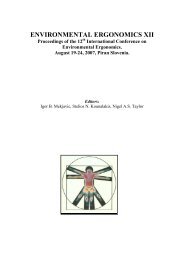Development of self-compacting concrete
Development of self-compacting concrete
Development of self-compacting concrete
Create successful ePaper yourself
Turn your PDF publications into a flip-book with our unique Google optimized e-Paper software.
Fig. 2. An example <strong>of</strong> congested reinforcement: an ideal<br />
application for SCC (Mott MacDonald Ltd)<br />
In addition to the benefits described above, SCC is also able to<br />
provide a more consistent and superior finished product for the<br />
client, with less defects. Another advantage is that less skilled<br />
labour is required in order for it to be placed, finished and<br />
made good after casting. As the shortage <strong>of</strong> skilled site labour<br />
in construction continues to increase in the UK and many other<br />
countries, this is an additional advantage <strong>of</strong> the material which<br />
will become increasingly important.<br />
This paper outlines the history <strong>of</strong> the development <strong>of</strong> SCC from<br />
its origins in Japan to its development in Sweden and the rest<br />
<strong>of</strong> Europe. The development <strong>of</strong> the material in Europe is then<br />
discussed, with particular reference to the UK.<br />
2. PROPERTIES OF SCC<br />
Most materials suitable for conventional <strong>concrete</strong> can be used<br />
in the production <strong>of</strong> SCC, although there are significant<br />
differences in SCC production compared with conventional<br />
<strong>concrete</strong> production. The most important is that the properties<br />
<strong>of</strong> the SCC can be allowed to vary only within much tighter<br />
limits. For conventional <strong>concrete</strong>, variation can be coped with<br />
by altering the degree <strong>of</strong> compaction work, but this is not<br />
possible with SCC. The properties <strong>of</strong> fresh SCC are also much<br />
more sensitive to variations in the quality and consistency <strong>of</strong><br />
the mix constituents. Because <strong>of</strong> its greater sensitivity to<br />
variation, batching accuracy for all component materials is<br />
essential for SCC to be successful.<br />
High powder contents are needed in SCC to increase the<br />
cohesiveness. Ground granulated blast furnace slag (GGBS),<br />
pulverised fuel ash (PFA), or an inert material such as<br />
limestone powder are most commonly used. It is possible,<br />
however, to produce an SCC without adding any extra fine<br />
material.<br />
The placement <strong>of</strong> SCC is the aspect <strong>of</strong> the building process that<br />
is changed most by the use <strong>of</strong> SCC. Once the fully compliant<br />
SCC is supplied to the point <strong>of</strong> application then the final<br />
operation <strong>of</strong> casting requires very little skill or manpower<br />
compared with traditional <strong>concrete</strong> to produce uniformly dense<br />
<strong>concrete</strong>. Because <strong>of</strong> vibration being unnecessary, the noise is<br />
reduced and the risk <strong>of</strong> developing problems due to the use <strong>of</strong><br />
vibrating equipment is reduced. Fewer operatives are required,<br />
but more time is needed to test the <strong>concrete</strong> before placing.<br />
In general, the hardened properties <strong>of</strong> SCC are similar or<br />
superior to those <strong>of</strong> equivalent conventional <strong>concrete</strong>. Provided<br />
the <strong>self</strong>-<strong>compacting</strong> properties are verified on site, a less<br />
variable and denser <strong>concrete</strong> is achieved. It could also be said<br />
that the compaction, and therefore durability, <strong>of</strong> the <strong>concrete</strong> is<br />
more guaranteed with the use <strong>of</strong> SCC as it reduces the potential<br />
for human error (in the form <strong>of</strong> poor compaction). The high<br />
fines content and the need for well-graded aggregates also<br />
improves the <strong>concrete</strong>, producing a more dense interfacial<br />
transition zone between the aggregate and the cement matrix.<br />
All these effects are beneficial for both strength and durability,<br />
although because <strong>of</strong> its relatively recent use, knowledge <strong>of</strong><br />
long-term durability is restricted to a decade <strong>of</strong> limited use.<br />
At similar water/cement ratios the characteristic strength <strong>of</strong><br />
SCC is at least equal to that <strong>of</strong> conventional <strong>concrete</strong>, and has<br />
a similar strength development for the same grade. Due to the<br />
low water/cement ratio used in SCC the compressive strength<br />
will generally be above C40 and can be up to C100. The tensile<br />
strength is also comparable to the same grade <strong>of</strong> conventional<br />
<strong>concrete</strong> and drying shrinkage is also similar.<br />
3. THE HISTORY OF SCC<br />
The history and development <strong>of</strong> SCC can be divided into two<br />
key stages: its initial development in Japan in the late 1980s<br />
and its subsequent introduction into Europe through Sweden in<br />
the mid- to late-1990s.<br />
3.1. Japan<br />
SCC was first developed in Japan in 1988 in order to achieve<br />
more durable <strong>concrete</strong> structures by improving the quality<br />
achieved in the construction process and the placed material. 1<br />
The removal <strong>of</strong> the need for compaction <strong>of</strong> the <strong>concrete</strong><br />
reduced the potential for durability defects due to inadequate<br />
compaction (e.g. honeycombing). The use <strong>of</strong> SCC was also<br />
found to <strong>of</strong>fer economic, social and environmental benefits<br />
over traditional vibrated <strong>concrete</strong> construction. These benefits<br />
included faster construction and the elimination <strong>of</strong> noise due to<br />
vibration. One <strong>of</strong> the main drivers for the development <strong>of</strong> the<br />
technology was the reduction in the number <strong>of</strong> skilled site<br />
operatives that the Japanese construction industry was<br />
experiencing in the 1980s. The use <strong>of</strong> SCC meant that less<br />
skilled labour was required for the placing and finishing <strong>of</strong> the<br />
<strong>concrete</strong>.<br />
SCC was developed from the existing technology used for high<br />
workability and underwater <strong>concrete</strong>s, where additional<br />
406 Structures & Buildings 156 Issue SB4 Self-<strong>compacting</strong> <strong>concrete</strong> development<br />
Goodier
















